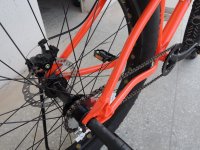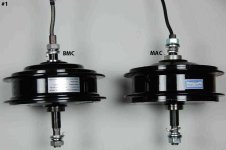Boodyhole
1 mW
I'm planning my first build, reading everything I can, but I'm hitting roadblock after roadblock on getting info about fatbikes. Here's the plan so far;
Bike; Gravity Deadeye Monster, 21in (I'm 6'5 - 220lbs) http://www.bikesdirect.com/products/gravity/fat-bikes/fat-bikes-deadeye-monster.htm
Battery; 48V 25Ah LiFePO4 from Sun-things28 http://www.ebay.com/itm/48v-25ah-Li...598914?hash=item2118f48582:g:ticAAOSw6BdXMEcC
I was originally going to do a 20Ah, because it was the smallest they make that still pushes enough current, but for the $50 extra, I decided to go 25. They're both the same size (somehow?)
Motor; Ebay special 1000W 48V rear kit. Whatever one's cheapest at the time, or maybe one close in price with a thumb throttle. (As a side, is there a marked difference between the ones that look like the 9C RH205 and the ones with the concentric bare metal circles on them?)
My plan is to modify a Fat Rim with the hub from the Ebay kit. I'm fairly competent with tools, and mechanical things.
Now I start having lots of trouble finding information. The only article I found that was helpful at all is this one https://electricbike-blog.com/2015/03/10/pita-hub-builds-on-fat-bike-rims-101/
The process seems straight forward enough. I know It will be frustrating at times, but I know I can handle it. My problem is that I can't find any drawings or dimensions of anything. I don't know where the motor hub sits, where the bike's stock wheel's hub is, or if it's offset.
I'm looking at rims. I've basically settled on the Origin8 AT-PRO801-UL http://www.niagaracycle.com/categories/origin8-rim-26x4-0-at-pro801-ul-36-72-black
It's one of the few fat rims that uses 36H, which is on the chinese ebay special hub motors. It also seems like it can be offset laced - or- laced normally.
I'm thinking about just buying the Bike, Kit, and battery. The bike and Kit should come in first while I wait 2 months for the battery to arrive. I can assess the rim situation, and order then. Make some torque arms. Should be enough time to get everything sorted out. I have a friend with a battery to test the kit before disassembly.
Worse case scenario, I wind up buying a normal steel frame single speed, re-assembling the original hub, and riding that... Have an extra stock fatbike for fun.
Does anyone know -anything- that will help me? Thanks!
Bike; Gravity Deadeye Monster, 21in (I'm 6'5 - 220lbs) http://www.bikesdirect.com/products/gravity/fat-bikes/fat-bikes-deadeye-monster.htm
Battery; 48V 25Ah LiFePO4 from Sun-things28 http://www.ebay.com/itm/48v-25ah-Li...598914?hash=item2118f48582:g:ticAAOSw6BdXMEcC
I was originally going to do a 20Ah, because it was the smallest they make that still pushes enough current, but for the $50 extra, I decided to go 25. They're both the same size (somehow?)
Motor; Ebay special 1000W 48V rear kit. Whatever one's cheapest at the time, or maybe one close in price with a thumb throttle. (As a side, is there a marked difference between the ones that look like the 9C RH205 and the ones with the concentric bare metal circles on them?)
My plan is to modify a Fat Rim with the hub from the Ebay kit. I'm fairly competent with tools, and mechanical things.
Now I start having lots of trouble finding information. The only article I found that was helpful at all is this one https://electricbike-blog.com/2015/03/10/pita-hub-builds-on-fat-bike-rims-101/
The process seems straight forward enough. I know It will be frustrating at times, but I know I can handle it. My problem is that I can't find any drawings or dimensions of anything. I don't know where the motor hub sits, where the bike's stock wheel's hub is, or if it's offset.
I'm looking at rims. I've basically settled on the Origin8 AT-PRO801-UL http://www.niagaracycle.com/categories/origin8-rim-26x4-0-at-pro801-ul-36-72-black
It's one of the few fat rims that uses 36H, which is on the chinese ebay special hub motors. It also seems like it can be offset laced - or- laced normally.
I'm thinking about just buying the Bike, Kit, and battery. The bike and Kit should come in first while I wait 2 months for the battery to arrive. I can assess the rim situation, and order then. Make some torque arms. Should be enough time to get everything sorted out. I have a friend with a battery to test the kit before disassembly.
Worse case scenario, I wind up buying a normal steel frame single speed, re-assembling the original hub, and riding that... Have an extra stock fatbike for fun.
Does anyone know -anything- that will help me? Thanks!



